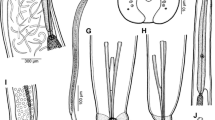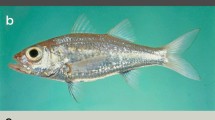Abstract
The surprising find of a single priapulid specimen off Rovigno (Istria, Jugoslavia) is the first record of a representative of this group in the Adriatic Sea; it is the second record of Priapulida in the Mediterranean Sea. The presence of cleptocnids, concentrated in scattered epidermic hills is unique, and leads to the establishment of the new species Priapulopsis (?) cnidephorus. The species is described; it possesses a longitudinal duct within the 8 double-layered, septa-like introvert retractor-muscles (Fig. 5).
Zusammenfassung
-
1.
Der Priapulide Priapulopsis (?) cnidephorus wird an Hand eines Individuums beschrieben, das in der Nähe von Rovigno (Istrien) in einer Schlammprobe gefunden worden ist.
-
2.
P. (?) cnidephorus ist der erste Priapulide, für den Cnidariennahrung nachweisbar ist und der unexplodierte Nesselkapseln aufgenommen und als Kleptocniden gespeichert hat.
-
3.
Das vorliegende Individuum repräsentiert den ersten Priapulidenfund im Adriatischen Meer und den zweiten Nachweis der Gruppe im mediterranen Be-Bereich.
Similar content being viewed by others
Zitierte Literatur
Apel, W.: Beitrag zur Anatomie und Histologie des Priapulus caudatus (Lam.) und des Halicryplus spinulosus (v. Sieb.). Z. wiss. Zool. 42, 459–529 (1885).
Guille, A. et L. Laubier: Découverte de la classe des priapuliens en Méditerranée. C.r. hebd. Séanc. Acad. Sci., Paris 261, 1125–1128 (1965).
Horst, R.: Die Gephyrea gesammelt während der zwei ersten Fahrten des “Willem Barents”. II. Hälfte: Priapulidae und Sipunculida. Archs néerl. Zool. (Suppl.) 1, 13–42 (1882).
Land, J. van der: A new aschelminth, probably related to the Priapulida. Zool. Meded., Leiden 42(22), 237–250 (1968).
—: Systematics, zoogeography, and ecology of the Priapulida. Zool. Verh., Leiden 112, 1–118 (1970).
Salvini-Plawen, L. v.: Chidaria as food-sources for marine invertebrates. Cah. Biol. mar. 13, 385–400 (1972).
Salvini-Plawen, L. v.: Zur Morphologie und Systematik der Priapulida: Chaetostephanus praeposteriens gen. et spec. nov., der Vertreter einer neuen Ordnung Seticoronaria. Z. zool. Syst. EvolForsch. 11 (1973).
Sanders, H. and R. Hessler: Priapulus atlantisi and Priapulus profundus. Two new species of priapulids from bathyal and abyssal depths of the North Atlantic. Deep Sea Res. 9, 125–130 (1962).
Werner, B.: Die Nesselkapseln der Cnidaria, mit besonderer Berücksichtigung der Hydroidea. Helgoländer wiss. Meeresunters. 12, 1–39 (1965).
Author information
Authors and Affiliations
Additional information
Communicated by O. Kinne, Hamburg
Rights and permissions
About this article
Cite this article
Salvini-Plawen, L.v. Ein priapulide mit kleptocniden aus dem adriatischen meer. Marine Biology 20, 165–169 (1973). https://doi.org/10.1007/BF00351455
Accepted:
Issue Date:
DOI: https://doi.org/10.1007/BF00351455




